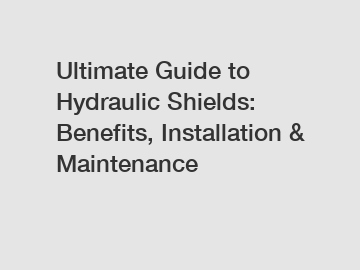Ultimate Guide to Hydraulic Shields: Benefits, Installation & Maintenance
Hydraulic shields are crucial components of hydraulic systems, providing protection against leaks, spills, and other potential hazards. In this ultimate guide, we will explore the benefits of hydraulic shields, how to install them, and essential maintenance tips to ensure they function effectively.
Benefits of Hydraulic Shields.
Hydraulic shields offer several key benefits that make them indispensable in any hydraulic system. Firstly, they prevent oil leaks and spills, which can be not only messy but also hazardous. By containing leaks, hydraulic shields help to maintain a clean and safe working environment.

Additionally, hydraulic shields help to protect hydraulic components from external damage. Whether from impact or debris, shields act as a barrier, ensuring that essential parts of the system remain intact and operational. This protection extends the lifespan of hydraulic equipment and reduces the likelihood of costly repairs or replacements.
Finally, hydraulic shields can enhance the overall performance of a hydraulic system by maintaining consistent pressure and temperature levels. By reducing fluctuations in pressure and temperature, shields help to optimize the efficiency and reliability of the system.
Installation of Hydraulic Shields.
Installing hydraulic shields is a relatively straightforward process, but it is essential to follow specific steps to ensure proper installation and functionality. Firstly, identify the components of the hydraulic system that require shielding and select shields that are compatible with those components.
Next, carefully position the shields around the components, ensuring that they provide adequate coverage and protection. Secure the shields in place using the appropriate fasteners, such as screws or bolts, to prevent them from shifting or coming loose during operation.
Finally, test the hydraulic system to ensure that the shields are functioning correctly and that there are no leaks or other issues. If necessary, make any adjustments or improvements to the shields to optimize their performance.
Maintenance of Hydraulic Shields.
Proper maintenance of hydraulic shields is essential to ensure their continued effectiveness and longevity. Regularly inspect the shields for signs of wear, damage, or corrosion, and replace them as needed to maintain optimal protection.
Additionally, clean the shields regularly to remove any dirt, debris, or oil buildup that could affect their performance. Use a mild detergent and water to clean the shields, taking care not to damage or distort them in the process.
Finally, monitor the hydraulic system for any signs of leaks, spills, or other issues that could compromise the effectiveness of the shields. Address any problems promptly to prevent further damage to the system and ensure the continued protection provided by the shields.
Conclusion.
In conclusion, hydraulic shields are essential components of hydraulic systems, offering protection against leaks, spills, and external damage while enhancing system performance. By understanding the benefits of hydraulic shields, following proper installation procedures, and maintaining them regularly, you can ensure the continued functionality and efficiency of your hydraulic system.
For more information on hydraulic shields or to inquire about our products and services, please contact us.
Contact us to discuss your requirements of sae 100r17 hose specification, four wire spiral hydraulic hose factories, black wire braid hydraulic hose factories. Our experienced sales team can help you identify the options that best suit your needs.
324
0
0


Comments
All Comments (0)